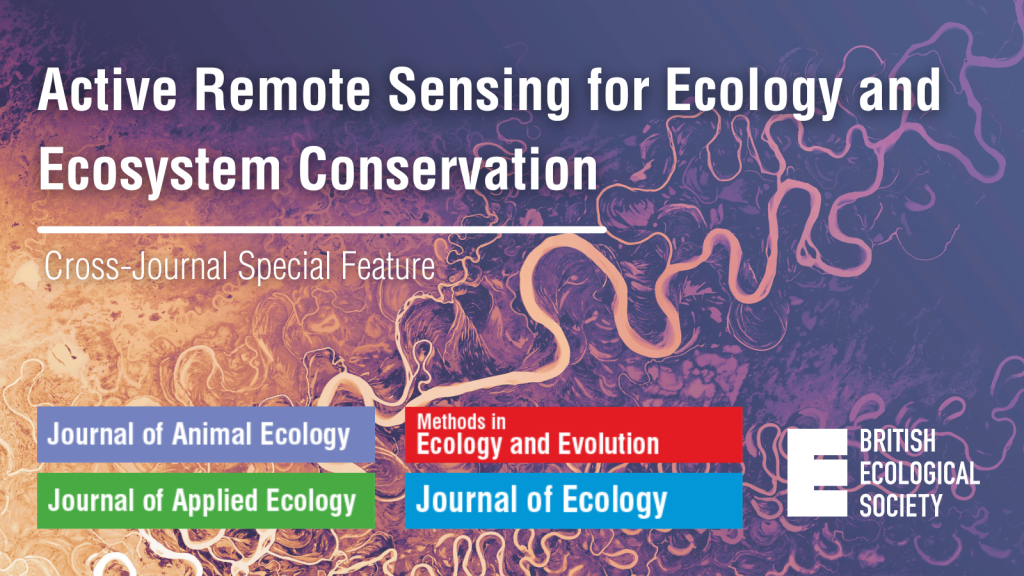Our July issue contains a Special Feature on active remote sensing for ecology & ecosystem conservation. Published jointly in Journal of Ecology, Methods in Ecology and Evolution, Journal of Applied Ecology, and Journal of Animal Ecology.

Active sources of remote sensing data, in particular LiDAR and RADAR, majorly differ from passive sources by offering data of 3D character, which improve representation of the earth’s terrain, surface and related structural attributes. Therefore, active remote sensing and the methods developed for its data analysis can support ecosystem inventory and analysis. This cross-journal special feature hosts 18 innovative publications from multiple disciplines, but with a common focus on the state-of-the-art science and applications of active remote sensing for ecology, biodiversity and conservation. Below is a selection of the articles published in the Special Feature:
Introductory Editorial
Towards complex applications of active remote sensing for ecology and conservation (Latifi et al.)
The studies in this Special Feature and trends shown by other recent works at the interface of ecology and active RS confirm the ongoing shift from indirect and solely proxy-based approaches, to direct and more data-science driven methods, in approaching ecology and conservation problems by means of active sensors. Relatively affordable and accessible drone and citizen science-based on-demand active RS data acquisition are becoming common practice, and the future of sensor development is hypothesized to go beyond the current domination of very high spatial resolution data and towards multiple spaceborne platforms. These tools and methods will support spatial upscaling, uncertainty analysis, large-scale mapping and monitoring of wildlife dynamics, among other topics that can take advantage of multitemporal/time series data. Nevertheless, access to demanding and costly very high-resolution data sources may still be maintained and optimized by establishing international and public–private partnered data pools.
Featured articles in Journal of Ecology
Unravelling the relationship between plant diversity and vegetation structural complexity: A review and theoretical framework (Coverdale et al.)
Vegetation structural complexity (VSC) is an important ecosystem trait that is typically associated with greater ecological functioning. Recent studies have also revealed that more diverse plant communities tend to be more structurally complex. However, the shape and generality of this relationship—and the mechanism(s) by which phytodiversity might contribute to structural complexity—remain poorly understood. The authors propose a theoretical framework for the relationship between phytodiversity and VSC based on classic biodiversity-ecosystem functioning principles. Using data from recently published studies that compare VSC across phytodiversity gradients, they find that the relationship between phytodiversity and VSC appears to be almost universally positive.
Airborne laser scanning reveals uniform responses of forest structure to moose (Alces alces) across the boreal forest biome (Petersen et al.)
Analysis of ALS data from distributed exclosure experiments identified a largely uniform response of forest canopies to moose across regions, facilitating scaling of moose impacts across the whole biome. This is an important step towards incorporating the effect of the largest boreal herbivore on the carbon cycling of one of the world’s largest terrestrial biomes.
UAV-Lidar reveals that canopy structure mediates the influence of edge effects on forest diversity, function and microclimate (Blanchard et al.)
Accounting for fine-scale variation in canopy structure captured by UAV-LS provides insights on the multiple edge effects on key forest properties related to structure, diversity, function, biomass and microenvironmental conditions. Integrating UAV-LS-derived data can foster our understanding of cascading and interacting impacts of anthropogenic influence on tropical forest ecosystems and should help to improve conservation strategies and landscape management policies.
This study uncovers the interactive effects of topography, disturbance history and vegetation structure in determining the taxonomic and functional diversity of ant assemblages in subtropical landscapes. Moreover, it demonstrates that remote sensed data can be leveraged to efficiently elucidate the complex effects of environmental change and disturbances on vegetation structure and consequently insect biodiversity, representing ecological proxies to refine ground investigation plans and support appropriate conservation and restoration measures for degraded landscapes.
Read the full Special Feature here: Active remote sensing for ecology & ecosystem conservation.





